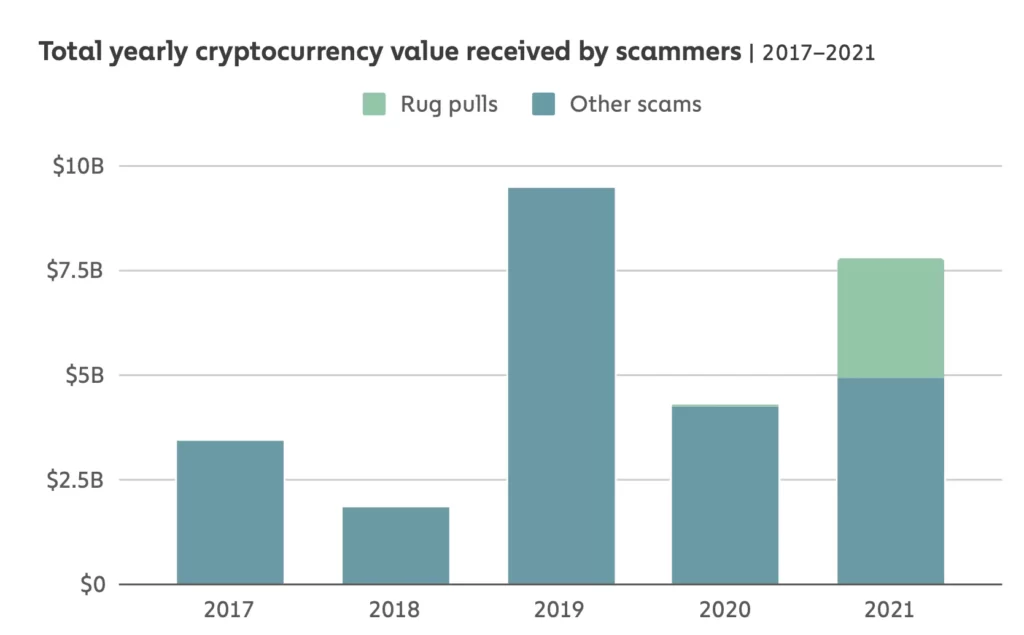There are over 22,000 cryptocurrencies and projects currently. While many of these projects are reliable with tremendous utility pushing the ecosystem forward, a sizable number operate under false pretenses. Crypto Ponzi Schemes have plagued the crypto space and its users due to the booming popularity of this emerging industry.
A Ponzi Scheme is an age-old get-rich-quick ploy and financial fraud that targets novice investors by posing as an elaborate investment opportunity. Investors who don’t recognize the characteristics of a Ponzi scheme run the risk of losing all of their money on these dubious projects.
A Brief History of Ponzi Schemes
A Ponzi scheme is not a type of financial fraud that has arisen due to the use of cryptocurrencies. This type of scam existed well before the inception of Bitcoin. Ponzi schemes have shaken the foundations of conventional financial markets for decades. The largest Ponzi scheme in recorded history is the Madoff investment scandal. According to estimates, Bernie Madoff defrauded tens of thousands of people for up to US$65 billion over the course of more than 20 years.
The phrase “Ponzi scheme” came into use in the 1920s, taking its name from the notorious con artist Charles Ponzi. However, despite Charles Ponzi’s notoriety as the scheme’s architect, the fraud that bears his name seems to have been first perpetrated in the late 1870s.
Understanding Ponzi Schemes
A Ponzi Scheme is a fraudulent investment opportunity that promises astronomical returns to its clients by distributing funds collected from new investors to pay earlier investors. These schemes frequently use risk-free and enormous returns as marketing gimmicks, which helps to maintain the appearance of legitimacy and attract new, inexperienced investors. A Ponzi scheme rarely invests the user’s funds in the claimed or marketed underlying physical asset or financial investment.
Since Ponzi schemes constantly need a pool of new investors, the sustainability of such fake investment schemes relies on constant cash flow. A Ponzi bubble bursts when the total number of investors increases while the supply of potential new investors decreases. The ruse is exposed when the fraud perpetrators can no longer pay their participants. The offenders eventually flee with any remaining investor funds and any profits they have made.
Crypto Ponzi Schemes in the Crypto Space
The innovative nature of cryptocurrency and its underlying blockchain technology allows for potentially high investment returns, particularly in sectors expected to see widespread adoption in the near future. However, given that the industry is still in its infancy, the massive profits attract individuals who either do not fully understand the technology or have little to no investing experience.
Ponzi schemes are notorious for luring victims by touting their mastery or superior knowledge of a “new technology.” Hence, the nascent crypto industry opens the door to a pandora’s box in which malicious actors can use the inherent complexities of the technology and its novel appeal to their advantage.
Therefore, when developing strategies to defraud investors, most crypto ponzi schemes or scam projects capitalize on the asset class’s growing appeal, the possibility of discovering the next 1000x coin, and a general lack of understanding of the fundamentals of crypto technology.
Furthermore, blockchain technology’s decentralized and immutable nature, combined with the regulatory ambiguity surrounding cryptocurrencies, makes them a top target for those who run Ponzi schemes.
According to the latest Chainanalysis Crypto Crime Report, the most significant type of cryptocurrency-based crime, with over US$7.7 billion worth of cryptocurrencies stolen from victims in 2021, was scams. While the emergence of rug pull scams, in particular, has contributed to the increase in lost funds recently, Ponzi schemes like Finiko illustrate the ongoing presence of this type of fraud. One Coin, Bitconnect, and Bitclub Network are a few other examples of the largest Crypto Ponzi schemes to rock the crypto ecosystem.

Common Red Flags
Ponzi schemes are frequently identified by a few red flags. Therefore, it is crucial for those in the cryptocurrency industry to proactively pay attention to the warning signs listed below.
Extraordinarily High and Guaranteed Returns
Any investment carries a certain risk. Ponzi schemes frequently resemble projects that promise significant investment returns and use those promises to entice investors. The security of a quick and risk-free investment, despite market conditions, is a telltale sign of Ponzi schemes.
Secretive or Complex Business Model
Ponzi schemes employ complex trading strategies in their marketing to obtain high yields with little risk. This is done to deflect attention and scrutiny. Therefore, it is vital to drift from projects with a vague investment or business model that doesn’t clearly disclose how returns are generated.
A High Degree of Centralization
It is essential to learn from the past. In this case, the One Coin Ponzi scheme highlighted this red flag. The One Coin ploy operated on a native and exclusive marketplace, which gave investors only one avenue to withdraw their funds.
Multilevel Marketing
MLM structures are at the heart of Ponzi schemes. Projects that heavily advertise hierarchical structures, multiple tiers of users, referral programs, and attractive commissions for new recruits are all signs of a Crypto Ponzi schemes project.

Conclusion
While Ponzi schemes frequently collapse under their own weight, the timeline for the bubble to burst is uncertain. Therefore, it is always best for investors to take proactive steps to increase their investment knowledge to protect themselves from falling for such scams.
Cryptocurrency is a disruptive technology likely to impact many industries. The sector’s potential for significant returns is evident, and scammers are preying on this allure. The lesson from this is that, even though Ponzi schemes and other types of scams are likely to continue, it is always wise to conduct research before making a crypto investment decision, regardless of how trustworthy the platform offering the opportunity may seem to be.




















